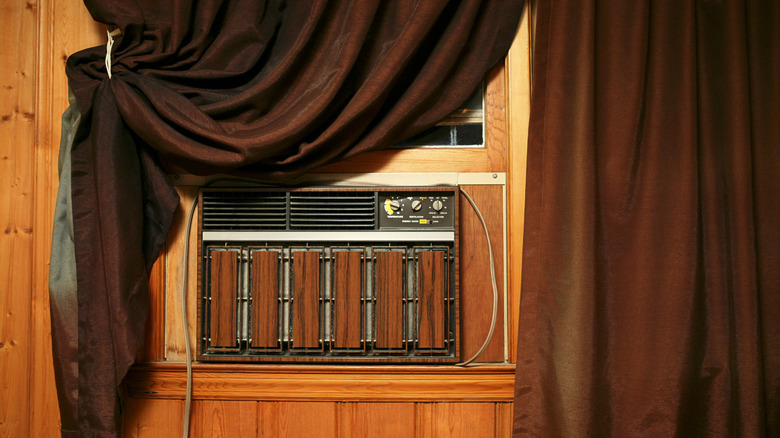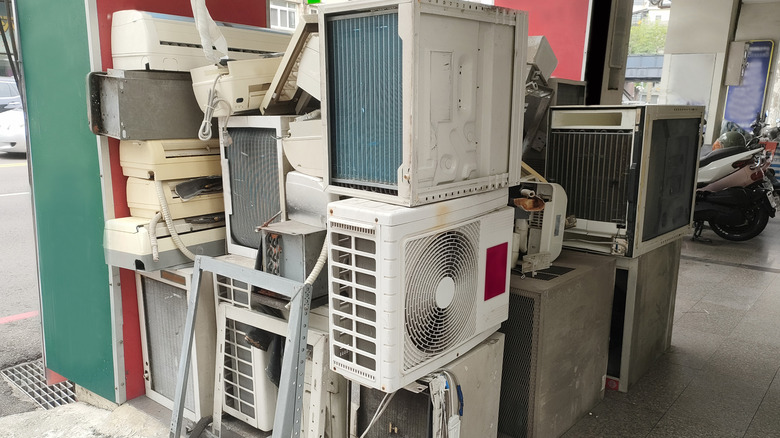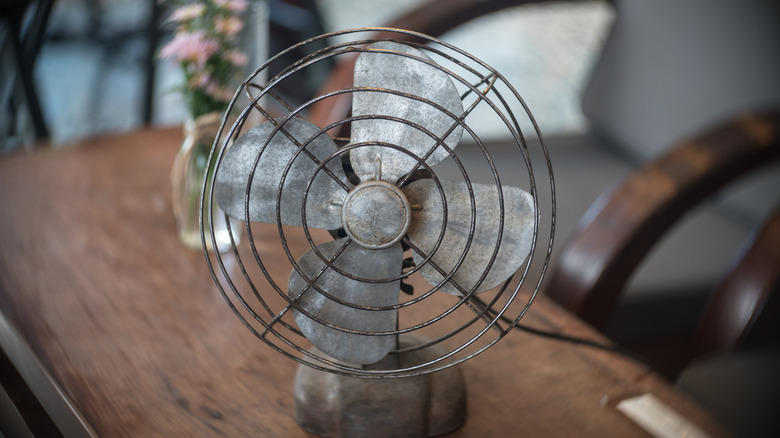Are Vintage Air Conditioners Worth Buying & Using? Here's What To Know
As you look for an affordable new way to cool down your home, you may wonder if it is worth buying and installing a secondhand air conditioner. Or, maybe you purchased a home that still has an older AC system or window unit. Before you drop some cash and install one of these funky finds, you need to know if vintage air conditioners are worth buying and using. And we hate to be the bearer of bad news, but sadly, the answer is not really.
While by the end of the '60s most homes had one of these cooling mechanisms, in general, window AC units need to be replaced about every 10 years, while central air systems last up to a couple of decades. However, with the right care, a retro air conditioning system or appliance can still work today. If you can somehow find a working one of these, you'll come to find out that they do get pretty cold and have no problem hitting set temperatures, making it apparent why they revolutionized the nation. But here's the kicker — it isn't worth it to buy these used older AC units because they come with a slew of their own issues, like higher costs, energy efficiency, and environmental problems. So while they do an excellent job at cooling a room, you may find yourself in a bigger pickle. However, you don't have to sacrifice your love of vintage items to stay cool — utilize a retro fan or ceiling fan instead.
Skip vintage air conditioners because of costs, energy efficiency, and environmental issues
While these cooling units look groovy, you don't necessarily what one in your home. These older models have multiple issues, including high costs, energy efficiency problems, and environmental concerns. You'll find that throughout all the issues, costs play some kind of factor. But one of the main reasons why vintage air conditioners are not recommended is because of their SEER ratings, an energy efficiency measuring system, falling in the low numbers, even as low as 6. For a better understanding, to be considered one of the best energy ranking units, you need to have a score of 14 or higher. With a higher SEER ranking, expect lower energy bills.
One of the most concerning problems with retro AC systems is that they needed R-22, which is a refrigerant that has now been banned, as it contributed to the depletion of the ozone layer. Currently, it is illegal to make this chemical liquid, and if you do end up finding some, it's extremely costly. And don't just dump contemporary refrigerants because it can kill the appliance quickly. While you can do some modern updates, expect those to cost just as much as a new replacement. So while your old-fashioned cooling system may look good in your space, it may be time to replace your window unit or central AC system to a better alternative that still keeps the retro vibes, like vintage electric fans and ceiling fans.
Set up a vintage fan
We understand loving the retro look, but you don't have to risk it with vintage air conditioners and window units; instead, an old-fashioned electric fan or ceiling fan will do the trick. Vintage electric fans were created with longevity in mind, made with durable steel or brass blades and hand-wired electrical components. Larger fans can be placed in bigger areas, like an entertainment room or living room, as well as be set up in garages, sheds, and outdoor settings. Smaller fans can be dispersed in different rooms, like when you put one on a desk as you are updating your home office. Some people are even using these antique finds as cooling décor pieces for events, like outdoor parties and weddings.
If you want something more permanent, a vintage ceiling fan may be a better alternative. Some versions are available at specific boutique stops, but they also have antique-looking contemporary ones that follow modern wiring and workings. Just like fans, these ceiling additions were made to last with cast iron, brass, wood, and hand-wired components. Before installing one, get your wiring checked by a professional to ensure it is safe. You also can restore it before installation to match your current home's look. However, if you see rust or wiring issues on either option, skip the piece unless you are ready to do restoration work or call a professional for help. Also make sure the blades are in working condition and spin correctly.


